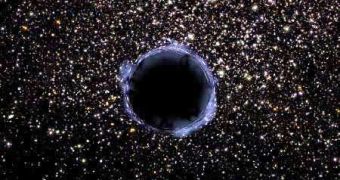It has been theorized some time ago that supermassive black holes may be ejected from their galaxy during a galactic collision. However, until now such event remained unobserved. When two or more galaxies merge into a single one their supermassive black holes may also merge, albeit the energy released during such a process would throw the merger out of its home world.
"We have observed the pre-merger stages of black holes. But we haven't seen the actual merger event", explains Max Planck Institute for Extraterrestrial Physics investigator, Stefanie Komossa who is also part of the team that made the discovery. The black hole discovered by them, a merger with a mass at least 100 million times that of the Sun, was seen speeding away from the galactic core.
"The consequence was that the merged black hole, the final product, the new black hole was expelled from the galaxy", said Komossa.
In theory, most galaxies contain supermassive black holes in their centers, thus when two galaxies collide, the inevitable collision between the supermassive black holes must occur as well. All they need is time. "One possibility is that for a long time they just orbit each other, just like a binary stellar system", says Komossa. After a while, the black hole orbiting the other may interact with a cosmic body or a cloud of gas and the additional drag would decrease its angular momentum to a point where collision is imminent.
"That would be a way to push them even closer towards each other", she said. The black holes eventually collide, fuse and merge, during which time massive amounts of energy is emitted into the surrounding space in the form of gravitational waves. "Since these waves are generally emitted in one preferred direction, the black hole is then kicked in the other direction.", the scientist explained.
The supermassive black hole detected by Komossa's team is traveling away form the galaxy at a speed of 9,400,000 kilometers per hour, much faster than the escape velocity of the gravitational field generated by the galaxy, meaning that it will eventually lose itself into intergalactic space.
To be more precise, the galaxy will remain without a central supermassive black hole. It is widely believed that the evolution of galaxies and black holes are linked together, so it is unknown what would happen to the two after being separated from one another. In some cases for example, the black hole doesn't have enough speed to escape the core and it oscillates on an up and down direction in relation to the galactic disk, until dissipating the excess energy and settling back into its place. Usually such oscillations produce high disturbances on the orbits of the stars in the galactic nucleus.

 14 DAY TRIAL //
14 DAY TRIAL //